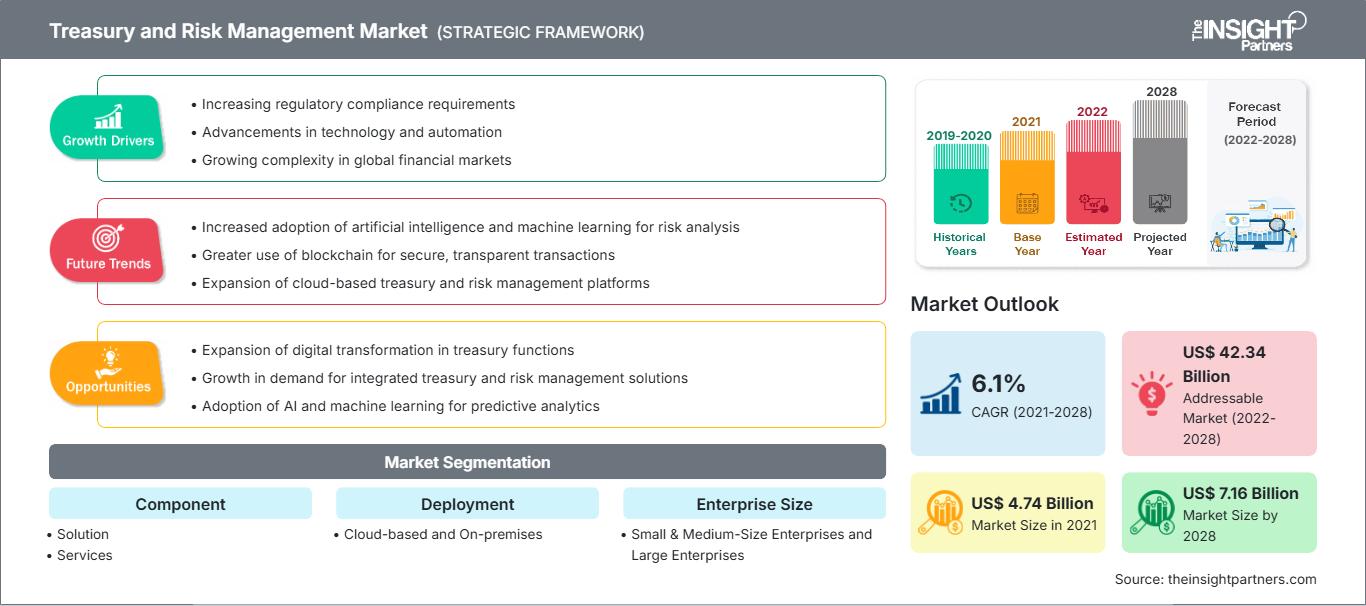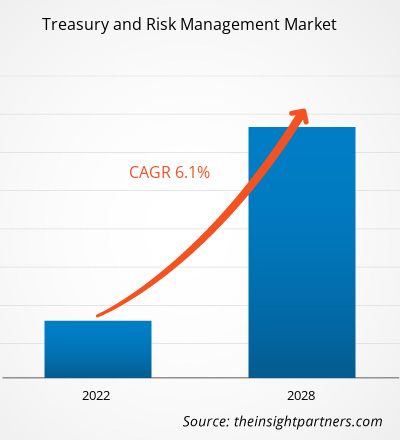財務およびリスク管理市場は、2021年の47億3,939万米ドルから2028年には71億5,690万米ドルに成長すると予想されており、2021年から2028年にかけて6.1%のCAGRで成長すると推定されています。
人工知能(AI)は、金融業界が信用判断から財務および金融リスク管理における定量分析に至るまで、さまざまなプロセスを合理化および最適化するのに役立ちます。AIソリューションは、信用判断プロセスにおいて、ミレニアル世代を含む従来十分なサービスを受けられなかった借り手のより正確な評価を容易にし、銀行や信用貸付業者がより賢明なビジネス上の意思決定を行うのに役立ちます。さらに、AIは多くの銀行、投資会社、資産管理会社における資金調達プロセスを円滑化し、自動化します。例えば、aixigo AGは、デジタルトランスフォーメーション、プライベートバンキング、リテールバンキング、ロボアドバイザー、資産運用サービスを提供するために、AIベースのウェルスマネジメントソリューションを活用しています。aixigo AGのロボアドバイザーソフトウェアは、金融投資プロセスにおける販売時点管理において、AIを活用して人間の役割を代替します。同様に、Synechron Inc.は、金融サービス業界向けにNeoというAIベースのソリューションを提供しています。Neoは、Synechronのデジタル、ビジネス、テクノロジーコンサルティングを独自に組み合わせ、金融機関が複雑なビジネス課題を克服するためのAIソリューション導入を支援します。そのため、銀行、投資会社、ウェルスマネジメント会社におけるAIベースの支援の普及が進むことで、予測期間中に財務およびリスク管理の市場シェアが拡大すると予想されます。
要件に合わせてレポートをカスタマイズ
レポートの一部、国レベルの分析、Excelデータパックなどを含め、スタートアップ&大学向けに特別オファーや割引もご利用いただけます(無償)
財務およびリスク管理市場: 戦略的洞察

- このレポートの主要な市場動向を入手してください。この無料サンプルには、市場動向から見積もりや予測に至るまでのデータ分析が含まれます。
レポートの一部、国レベルの分析、Excelデータパックなどを含め、スタートアップ&大学向けに特別オファーや割引もご利用いただけます(無償)
財務およびリスク管理市場: 戦略的洞察

- このレポートの主要な市場動向を入手してください。この無料サンプルには、市場動向から見積もりや予測に至るまでのデータ分析が含まれます。
COVID-19パンデミックによる世界の財務・リスク管理市場への影響
COVID-19パンデミック以前は、デジタル化の進展により、財務・リスク管理ソリューション/サービスの需要が高まっていました。例えば、2019年4月にBusiness Wireが発表した記事によると、2019年のデジタルトランスフォーメーションへの支出は1.18兆米ドルで、2018年比17.9%増加しました。
財務・リスク管理市場分析によると、2020年には、COVID-19パンデミックが企業の運営に著しく影響を及ぼし、ビジネスの基本的な側面を変えました。2020年のCOVID-19の蔓延により、危機を回避し感染リスクを最小限に抑えるために、いくつかの国で世界的なロックダウンが実施されました。これにより、COVID-19の流行中に企業の機能を維持するためのデジタル技術の導入が一大ブームとなりました。ほとんどの企業はクラウドインフラストラクチャに移行し、ロックダウン制限を維持しながら事業を継続しました。さらに、COVID-19パンデミックは、企業がデジタル化、統合リスク管理、コスト最適化とキャッシュマネジメントへの新たな焦点に合わせて企業財務の将来について考えるよう促しました。このように、財務およびリスク管理ソリューション/サービスの導入は2020年に増加しました。したがって、2020年のCOVID-19パンデミックによる財務およびリスク管理市場への全体的な影響はプラスでした。
2021年と2022年の財務およびリスク管理市場分析によると、ロックダウン措置の緩和、複数の企業によるクラウド技術の導入、および現金管理のための人工知能(AI)や機械学習などの技術による自動化に向けた組織の移行は、財務およびリスク管理市場の成長にプラスの影響を与えています。例えば、2021年5月には、RefinitivとIBSFINtechが、クラウドベースの新しい自動財務管理ソリューションの提供に向けた提携を発表しました。InTReaXと名付けられたこのソリューションは、現金・流動性、および為替リスクの管理ソリューションとなります。このように、多くの企業がクラウドベースの財務管理ソリューションを導入することで、市場プレーヤーに様々なビジネスチャンスが創出されるでしょう。
COVID-19パンデミック前の2019年の財務・リスク管理市場規模は43億3,746万米ドルでした。パンデミック中の2020年の市場規模は45億2,657万米ドルでした。さらに、2021年には47億3,939万米ドルに達しました。したがって、2020年にCOVID-19パンデミックが市場に与えた全体的な影響はプラスでした。
財務およびリスク管理市場の洞察
金融分析サービスの需要増加
組織は、財務分析ツールを使用して、現在および将来のいくつかの傾向に関する洞察を取得し、ビジネスパフォーマンスを向上させます。財務分析サービスは、財務データ品質分析、データレイアウト、クライアント分析、予測分析、主成分分析、および財務データ収集を提供します。これらの分析では、パターンを特定するために詳細な財務データやその他の関連データが必要です。この分析に基づいて、企業は顧客の購入と従業員の在籍期間に関する予測を行います。このように、財務分析サービスは、組織が収益性、キャッシュフロー、およびビジネス価値を向上させるのに役立ちます。これらの分析を通じて得られた洞察を使用して、収益とビジネスプロセスを改善できます。たとえば、Accenture PLCは金融サービスプロバイダーに最新のデータおよび分析ソリューションを提供し、その導入を支援しています。財務およびリスク管理レポート分析には、コスト分析と企業業績分析を含むこれらの企業向けサービスが含まれます。損益計算書、貸借対照表、キャッシュフロー計算書に重点を置いた財務分析は、経済動向の評価、財務方針の策定、長期事業計画の策定、投資対象プロジェクトや企業の特定に活用されます。金融は取引量の多いビジネスであるため、投資銀行などの金融サービスプロバイダーは、他のビジネスよりも多くのデータを生成・保管します。銀行はこれらのデータを用いてリスクを予測し、全体的な収益性を向上させます。このように、銀行や投資会社にはさまざまなメリットがあるため、財務分析サービスの需要が大幅に増加しており、財務およびリスク管理市場の成長を後押ししています。
財務機能は、顧客、競合他社、収益性、プロセスに関するより優れた洞察を提供する財務分析の明確な恩恵を受けています。また、財務分析は、最高財務責任者(CFO)の戦略的意思決定と投資計画の推進能力を強化することもできます。そのため、分析主導の組織の構築は、CFO と最高情報責任者 (CIO) のコラボレーションの最大の推進力にもなっています。そのため、財務分析サービスの需要が大幅に増加し、財務およびリスク管理市場を牽引しています。
コンポーネントベースの市場分析
コンポーネントに基づいて、財務およびリスク管理市場はソリューションとサービスに分かれています。ソリューション セグメントは 2020 年に大きなシェアを獲得して市場をリードしました。
導入ベースの市場分析
導入に基づいて、財務およびリスク管理市場はクラウドベースとオンプレミスに分かれています。クラウドベース セグメントは 2020 年に大きなシェアを獲得して市場をリードしました。
企業規模に基づく市場分析
企業規模に基づいて、財務およびリスク管理市場は小規模および大規模に分かれています。財務およびリスク管理市場は、中規模企業と大規模企業で構成されています。2020年には、大規模企業セグメントが大きなシェアを占め、市場をリードしました。
アプリケーションベースの市場洞察
アプリケーションに基づいて、財務およびリスク管理市場は、口座管理、現金および流動性管理、コンプライアンスおよびリスク管理、および金融リソース管理に分類されます。現金および流動性管理セグメントは、2020年に最大の市場シェアを占めました。
エンドユーザーベースの市場洞察
エンドユーザーに基づいて、市場はBFSI、ITおよび通信、小売およびeコマース、ヘルスケア、製造および自動車、その他に分類されます。 BFSIセグメントは、2020年に最大のシェアを獲得し、財務およびリスク管理市場をリードしました。
財務およびリスク管理市場で活動しているプレーヤーは、合併、買収、市場イニシアチブなどの戦略を採用して、市場での地位を維持しています。主要プレーヤーによるいくつかの開発は次のとおりです。
- 2021年7月、FISは人工知能(AI)対応のリスクソリューションの新シリーズを発表しました。FISは、C3 AIと共同で作成した新しい製品セットを発表し、資本市場組織が組織データの力を活用して規制コンプライアンスとリスクをより適切に管理できるように支援しました。
- 2020年11月、北欧のチャレンジャーバンクであるLunarは、流動性の最適化、リスク管理、および拡張のサポートを得ることを目標に、財務およびリスク管理業界におけるFISのクラウドベースソリューションを選択しました。Lunarは、ヘッジ会計と規制コンプライアンスの簡素化のために、FISのプライベートクラウドベースのAmbit Quantumを選択しました。 Lunar は、FIS SWIFT サービス ビューローを利用して、SWIFT やその他の業界の取引所やネットワークを通じて、財務および支払い業務を銀行パートナーに接続しています。
財務およびリスク管理市場
予測期間を通じて財務・リスク管理市場に影響を与える地域的なトレンドと要因については、The Insight Partnersのアナリストが詳細に解説しています。このセクションでは、北米、ヨーロッパ、アジア太平洋、中東・アフリカ、中南米における財務・リスク管理市場のセグメントと地域についても解説します。
財務およびリスク管理市場レポートの範囲
| レポート属性 | 詳細 |
|---|---|
| の市場規模 2021 | US$ 4.74 Billion |
| 市場規模別 2028 | US$ 7.16 Billion |
| 世界的なCAGR (2021 - 2028) | 6.1% |
| 過去データ | 2019-2020 |
| 予測期間 | 2022-2028 |
| 対象セグメント |
By コンポーネント
|
| 対象地域と国 | 北米
|
| 市場リーダーと主要企業の概要 |
|
財務およびリスク管理市場のプレーヤー密度:ビジネスダイナミクスへの影響を理解する
財務・リスク管理市場は、消費者嗜好の変化、技術の進歩、製品メリットへの認知度の向上といった要因によるエンドユーザー需要の高まりに牽引され、急速に成長しています。需要の高まりに伴い、企業は提供内容の拡充、消費者ニーズへの対応のためのイノベーション、そして新たなトレンドの活用を進めており、これが市場成長のさらなる加速につながっています。

- 入手 財務およびリスク管理市場 主要プレーヤーの概要
企業プロフィール
- Broadridge Financial Solutions, Inc.
- FIS
- Oracle Corporation
- Pricewaterhousecoopers International Limited (PWC)
- SAP SE
- Fiserv, Inc.
- Calypso Technology, Inc (Adenza)
- Kyriba Corp
- Mors Software
- Wolters Kluwer
- 過去2年間の分析、基準年、CAGRによる予測(7年間)
- PEST分析とSWOT分析
- 市場規模価値/数量 - 世界、地域、国
- 業界と競争環境
- Excel データセット
最新レポート
関連レポート
お客様の声
購入理由
- 情報に基づいた意思決定
- 市場動向の理解
- 競合分析
- 顧客インサイト
- 市場予測
- リスク軽減
- 戦略計画
- 投資の正当性
- 新興市場の特定
- マーケティング戦略の強化
- 業務効率の向上
- 規制動向への対応




















 無料サンプルを入手 - 財務およびリスク管理市場
無料サンプルを入手 - 財務およびリスク管理市場